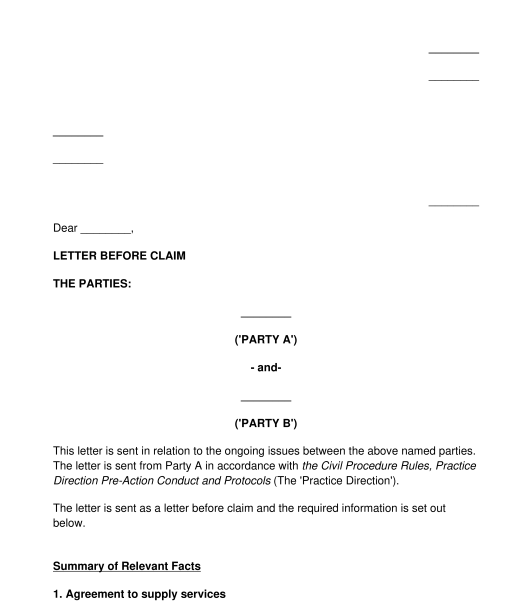 04/09/2025
04/09/2025

Answer a few questions and your document is created automatically.

Your document is ready! You will receive it in Word and PDF formats. You will be able to modify it.




Rating: 4.6 - 111 votes
Fill out the templateA letter before small claim is a letter that is sent before a claim is brought in the Small Claims Court in England and Wales. The letter will be used to explain why the sender believes they have an actionable legal claim against the recipient. The letter will offer the recipient the final opportunity to resolve the matter prior to the instigation of court proceedings.
If a business intends to instigate a claim for unpaid debt, a different letter is available. This type of claim follows a different pre-action protocol (the 'Debt Protocol'). If an individual person (i.e. not a business) intends to make a claim for debt, then this letter may be used as the debt protocol applies to businesses only.
A different pre-claim letter should also be used in the jurisdiction of Scotland.
A letter of complaint is different to a letter before claim. It is a more informal kind of letter. Usually, it will invite the recipient to resolve matters informally. The letter will not make detailed reference to any potential future claim, in the way that a letter before claim does.
A letter before claim will serve as a final warning and will provide one final opportunity for the recipient to resolve matters. The letter before claim must include particular, detailed information about the future claim. It will provide a specific deadline within which court proceedings will be issued, in the absence of any resolution.
Yes, it is always best to send a letter before claim. There are rules in place, governing civil claims in the Civil Court. Those rules say that a letter before claim should be sent before a claim is made. The Court will take into account any non-compliance with those rules during any future proceedings.
A small claim refers to a certain 'track' to which a case may be allocated within the Civil Court in England and Wales. The small claims track will be the usual track for:
Commonly, cases that are brought before the Small Claims Court relate to:
Once the letter has been completed with all the relevant information and signed, it should be sent to the other party. It may be printed, signed and posted to the other party. It may be helpful to have the letter sent by recorded/tracked delivery.
It is also acceptable to send the letter electronically via email. If this method is used, it may be helpful to request a read receipt on the letter.
The other party will be provided with a timeframe within which they must respond to the letter. Where no response is received, or where no satisfactory solution is reached, the claim may be issued in the Small Claims Court.
The sender may wish to include any relevant evidence to support their future claim. This will help to explain the basis of their claim. Evidence may include:
The letter should contain concise details about the claim. The letter should always include the following key information:
For personal injury and disrepair claims, further specific information must be included in relation to the details of those claims.
The laws that will govern the sender's case will depend upon the nature of the intended claim. Here are some examples of the key legal provisions applicable to common types of small claims:
The process for making civil court claims is governed by The Civil Procedure Rules and Practice Directions. In particular, it is helpful to look at:
It is also helpful to consider the provisions of The Limitation Act 1980 – to ensure any claim will be brought within the required time limit.
You fill out a form. The document is created before your eyes as you respond to the questions.
At the end, you receive it in Word and PDF formats. You can modify it and reuse it.
Guides to help you
Letter Before Small Claim - Template - Word & PDF
Country: United Kingdom